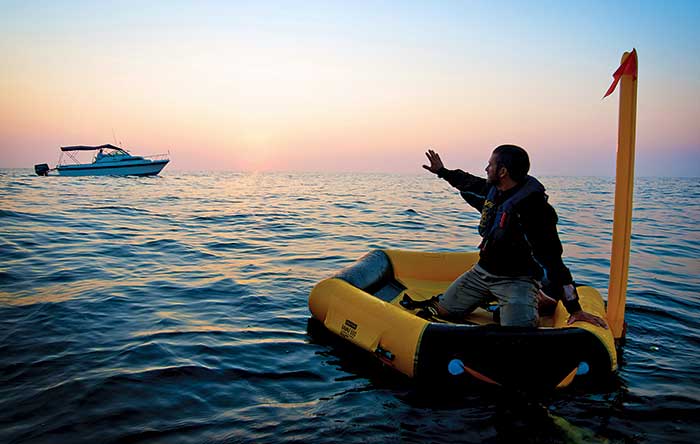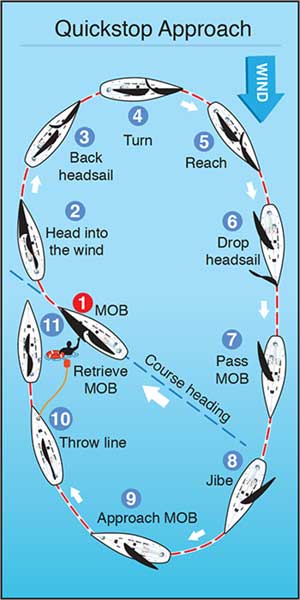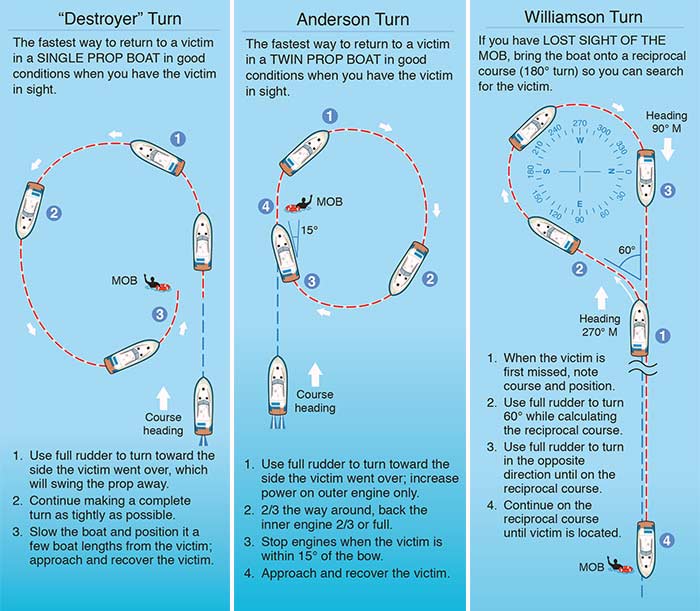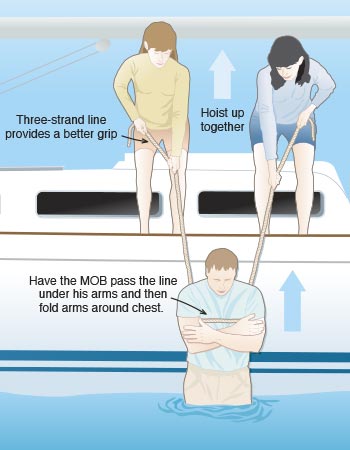Advertisement
Few of us plan for a crew member to fall overboard. Getting that person back aboard is harder than you think.

Man Overboard Modules (MOMs) like the Switlik 600 provide flotation and visibility.
Unless you do the right things, fast, when someone falls overboard, that person could be lost. Man-overboard (MOB) fatalities make up 24 percent of all boating deaths. Our BoatUS Foundation for Boating Safety and Clean Water has studied these incidents over a five year period and created a picture of the typical accident. The majority of cases do not involve bad weather, rough seas, or other extenuating circumstances. "Most happen on relatively calm waters, on a small boat that's not going very fast," said Chris Edmonston, president of the BoatUS Foundation. "Victims tend to be men. Fishing is a prime activity, and in many cases, alcohol is involved."

Illustrations: ©2012 Mirto Art Studios
Numerous articles have been written about recovering a lost crew member from a sailboat, but MOB procedures for powerboaters have seldom been addressed. In light of the profile above, we present a general overview of MOB scenarios and procedures for the benefit of all boaters, no matter the size of your boat. We include an accompanying sidebar, "Brother, Save Thyself," about how to get back aboard a small boat. We also present and illustrate the Quick-Stop method, favored by many sailboaters:
Know Your Boat's Characteristics
When someone falls overboard, it's critical to get to the victim quickly. Think about how you'll do this on your boat without endangering the victim with your prop. Consider the freeboard of your boat. If it's high, this makes it difficult to get a victim back aboard. If your boat has a squared chine (bottom), waves may cause the boat to crash down on a victim who's alongside, while a rounded chine may push the victim away from the boat and out of reach. Look at your stern platform. Will it help, or plunge down on a victim, pushing him underwater and perhaps into the props? Before there's an emergency, consider how these factors affect your boat's maneuverability, and fit your boat out with gear that might mitigate some of these challenges (see MOB equipment sidebar below).
Equipment To Locate MOB
No matter what size or type of boat you have, you should carry:
- USCG-approved floating cushions, ring buoys, and life jackets with colors that stand out at sea and that are readily available.These can help the victim float and help lead you back to him. (Life jackets with mirrors and waterproof lights are a smart idea.)
- A GPS with MOB feature.
Here are other MOB-location gear to consider carrying:
- AutoTether Screamer Wireless Alarm System sounds an alarm that a crewmember wearing a transmitter has gone overboard. The sooner you know you have an MOB, the more likely you are to find the victim in time.
- SafeLink R10 SRS (Survivor Recovery System) utilizes both GPS technology and the AIS system to help you and nearby AIS-equipped vessels find a victim.
- ResQLink+ by ACR is a personal locator beacon (PLB) worn by the victim that enables USCG to find and retrieve him. (Note: PLBs alert authorities, but not you, to the MOB. An MOB alarm enables you to respond immediately — particularly important if the water is cold and the victim has no flotation.)
- An MOB floating rescue flagpole that you can toss over the side. It unfurls a bright yellow flag that's easier to spot from a distance.
Equipment To Retrieve MOB
According to rescue professionals, getting an exhausted victim back aboard who may be unable to assist in the rescue can be far more challenging than returning to the victim. Every boat should be equipped with an easy way for someone to get aboard from the water.
On most boats, the best solution is a boarding ladder that's structurally strong, well-designed, easily put in place, and long enough for your freeboard and for the victim to climb easily. The ladder should be relatively vertical, stand off the hull for toe clearance (which a rope ladder doesn't do), have nonskid steps, and be capable of firmly attaching to the boat. Generally, a ladder mounted to the side is safer and easier to use than one on the stern.
If your boat has low freeboard and came with a boarding ladder, beware: Many built-on swing-down ladders don’t swing down deeply enough for an exhausted person to climb up, and they don't have adequate hand grips fastened to the boat for the victim to grab and pull. Most people have the greatest strength in their legs, not their arms. Improve your ladder and hand grip, or get a long ladder that hooks over the gunwale, such as the West Marine Portable Gunwale-Mount Boarding Ladder.
Lines with loops at each end can also be useful. They need to be of proper length to rig quickly for use as a handhold, support, or recovery sling.
Beyond these essentials, you may want to carry a MOM (Man Overboard Module) and/or a Lifesling. MOMs come in several models ranging from floats to platform rafts that rapidly release and inflate. The Lifesling has a floating yellow yoke, and you can buy a 5:1 purchase tackle to help pull the victim up .
Your boat must be set up in advance to properly utilize this gear. For example, the tackle that you can purchase with a Lifesling can help a weak person lift a heavy person out of the water. But a secure attachment point on the boat high enough above water (generally about 10 feet above the waterline) must be installed in advance. If there isn’t a high enough place to attach a securing point, the Markus Scramble-net or other equipment that doesn't require as high an attachment point may work for you.
Consider Your First Steps Before The Worst Happens
If you have an MOB, the following basic procedure needs to happen immediately. To prevent confusion from impeding swift action, practice. But remember, your exact actions must depend on many variables.
1. The instant someone falls overboard, yell "Man overboard!" to alert crew to the emergency, and establish an unceasing visual on the victim. If you have enough crew, assign this job to one person and let nothing interfere with that person keeping the victim in sight and pointing at the victim from that first moment on.
2. If you're unsure of where the person is or if there is a chance the props could endanger him, stop the boat and ensure that the props don't injure the victim now or later.
3. Activate your GPS MOB button if you have one.
4. Throw MOB gear, life jackets, flotation cushions anything that will help the victim float and help you keep track of him, but not so much as to confuse a search.
5. Return to and attempt to retrieve the victim. Several alternative methods are illustrated on these pages and discussed in the next section.
6. If the situation is life-threatening, call mayday three times on VHF 16. Then say, "Man overboard," and give your location, boat description, and the description of the victim. Do this three times in succession. Don't hesitate to issue a mayday you can always cancel it if you get the person back aboard safely.
Sea and wind state: When you get closer to the victim, determine how much and how fast the wind and sea are pushing your boat, which is having the most effect, and how fast you're drifting. If the sea is rough, it may be dangerous to come alongside the victim, especially if he's exhausted or injured. Go slowly. If he does not have flotation, try to toss him a flotation and/or retrieval device as you approach.
Water temperature: Sudden cold-water immersion can cause involuntary gasp reflex or cardiac arrest. Often a surprised MOB victim will instinctively gasp and suck in a large volume of water, which could lead to drowning. Also, a victim's loss of body heat may weaken and disorient him, limiting his ability to swim or help in his rescue. The victim should try to maintain core body heat for as long as possible by keeping his arms down and crossed, and knees bent up to his chest, if possible. Wearing a life jacket helps the victim's odds significantly.
Physical condition of victim: Excess weight, poor swimming ability, panic, lack of arm strength, injury, hypothermia, and other factors make retrieval extremely challenging. The person in the boat may need special equipment or assistance to get the victim aboard.
Skill, size, and ability of person(s) aboard: One person aboard a high-freeboard boat may find it almost impossible to get a victim aboard, particularly if either person isn't in good physical condition, or if the larger and/or more skilled person is in the water. Think about an alternative, such as a Lifesling, or another system that could work on your particular boat.Visibility:
Take a look around. If visibility is poor, slow down and make sure you know where the victim is. If an approaching fog bank or squall could reduce visibility soon, get back to the victim before you lose sight of him.
Other boats: If you're in a rough inlet with many boats racing past, position your boat to protect the victim and begin visual warning signaling. In some cases, it may be prudent to wait for help before you begin retrieval. One example would be if you were alone on board and another boat nearby with strong experienced swimmers and retrieval gear responded to your distress call and was on their way to the scene.
Sobering MOB Facts
Our BoatUS Foundation has created a snapshot of boating fatalities that occurred between 2003 and 2007, a five-year span that gives good insight on MOB accidents and how they happen, so that we can work to help lower those numbers. In that timeframe, 749 of the 3,133 total U.S. boating fatalities were MOB:
- 24% were characterized as "falls overboard."
- 24% died at night, and 76% died during the day.
- 82% were on a boat under 22 feet in length.
- 63% didn't know how to swim.
- Only 8% of the non-swimmers were wearing a life jacket.
- 90% of accidents occurred when water conditions were calm or had less than 1-foot chop.
- Just 4% of the boats had two engines.
- 85% of fatalities were men.
- Average age was 47.
- During the day, alcohol played a part in 27% of the deaths.
- At night, alcohol played a part in 50% of the deaths.
- Falling overboard while fishing accounted for 41% of the deaths.
— Chris Edmonston
Practice, Practice, Practice
If you want to save an MOB victim, the time to start is now. Begin planning and practicing what you'd need to do in your circumstances in your boat. This helps generate intuitive, appropriate reactions.
Practice MOB techniques by throwing a fender with a bucket attached into the water. Return to it, approach it, and get it aboard while being extremely careful that you keep the props away from the "victim."
The best equipment may be useless unless you know how to deploy it without thinking. For example, if you have a Lifesling with tackle, on a calm day, near shore, practice putting a person in the water, rig it, and use it. Also, practice with the "victim" pretending helplessness. The "victim" should be wearing a life jacket.
Practicing may teach you that the best you can do is to stabilize the victim safely alongside and call the Coast Guard for help on the VHF. Unless you're in really cold water, it usually takes a relatively long time to become unconscious due to hypothermia. The key is to keep the victim from drowning, getting injured, or becoming disconnected from the mother ship.
As you practice, think through contingency plans for each of the three steps necessary to retrieve a person who has gone over the side: Return to the victim, approach the victim, and get the victim aboard.
Return to the victim: If a person goes over the side while the boat is underway, it's normally best to turn toward the side he went over, in order to swing the stern and props away from the victim.

Three Alternatives For Returning To A Victim
You should know instantly when someone goes over if you're in a smaller center console. But in a larger boat, more time may pass before you notice. To find the victim, you will need to calculate and steer a reciprocal course back to the location. The illustrations above show several methods for returning to a victim. For more information, refer to the Coast Guard Boat Crew Seamanship Manual.
If you need to rely on the MOB feature on your GPS to find the victim, learn where that button is, now, so you can push it while doing everything else needed at the same time. Be sure you will understand, even under duress, what the GPS is telling you.
Approach the victim: Two effective alternatives for approaching the victim are illustrated above. Decide on the best approach based on factors including but not limited to sea state, current, whether other boats are approaching, your boat's characteristics, and your crew's capabilities. Have those responsible for pulling the victim aboard (hopefully more than just you) in position and ready.
In most situations, it is safest to approach the victim with your bow facing into the wind and waves. If possible, throw him a line when you get close enough. Then turn off the engine(s), pull the victim in to the boat, and bring him to the ladder-hoisting area. This will minimize the chance of striking the victim with the propeller.
On a smaller boat without a lot of windage, it may be safer to come to a controlled stop upwind of the MOB and drift down on him, with crew ready to reach over and grab him. This may prove challenging on a boat with a lot of windage and high freeboard, but relatively easy on a center console. In some circumstances, it may be better to approach downwind but circle closely and come into the wind next to the victim.
While it is usually safest to approach the MOB with the wind and waves over the bow, this may not be possible in a narrow channel, in large waves, near obstructions, or in other circumstances where maneuverability is limited. To prepare for these situations, practice approaching the victim with the wind and sea behind you, very slowly. Maintain control of the boat to avoid floating over the victim.

Lifesling, Towline, Or Ski-Rope Retrieval
If you have a Lifesling or other retrieving line, slowly circle the victim, towing the line behind the boat until it comes within the victim's reach (see illustration above). Then stop the boat and pull the victim in.

Get the victim aboard: The very best way to get a victim back aboard is with a strong, well-built ladder. If you don't have a ladder or a Lifesling with tackle, a recovery line looped under the victim's arms (see illustration) may enable one or more people to pull him up over a relatively high freeboard.
When trying to retrieve a victim and bring him back aboard into a center console with low freeboard, it may help to position the victim facing the boat with both arms reaching upward. If the person aboard has the necessary strength, he should reach down and grasp the victim's wrists; the victim should grab the rescuer's wrists; and the rescuer should lift the victim straight out of the water. If you have a net or tarp, you may be able to secure one side to your gunwale, carefully work the net/tarp under the victim, then hold him in place until more help comes.
MOB testing has proven that if the victim is helpless and unable to assist, it will be very difficult to get him back into the boat. If you have a strong swimmer aboard, conditions are appropriate, and it's safe to do so, consider having that person (wearing a life jacket) go in and help the victim get to and climb up a strong ladder. But remember that you now have two people in the water, and, potentially, two victims at risk. Calling mayday, keeping the victim next to the boat, and waiting for assistance may be a more prudent course of action.
Brother, Save Thyself
Approximately half of the 749 MOB fatalities reported in our "MOB Facts" sidebar occurred on boats with only one person aboard; in 190 fatalities (about 25 percent), only two people were aboard. This means that, many times, victims fall overboard from smaller boats – many while fishing alone or with one friend; they can't get back aboard their boats, and drown.
So, for small-boat operators, think about how to set up your boat so that you can effectively get back aboard yourself:
- Use an engine cut-off switch, especially if you're operating the boat alone.
- Make sure there's a sturdy boarding ladder either permanently attached to the boat, or where it can be reached from over the side.
- It can pay to simply secure a line to the boat, tie a loop in the end (large enough for your foot), and hang it over the side so you can reach it from the water. With the engine off, practice climbing aboard using the loop.
- On some boats, it may be possible to get back aboard using the back of your motor as a step. (Turn off the motor and remove the key before experimenting.)
- Wear a life jacket.
— C.E.
Crew Briefing
Each time you go out, make an MOB briefing part of your departure routine. Show people where life jackets are stowed. Better yet, encourage your crew to wear them. Most drownings occur quickly. If your crew are wearing life jackets when they go in the water, they'll stay alive longer and you will have a much better chance to save them.
Stress the necessity that someone keep an eye on an MOB victim at all times, point out throwing devices and recovery gear, show how they work, and explain challenges such as plunging stern platforms and rolling hard chines. Show crew where the radio is and how to broadcast a mayday. Also, before you set out with your crew for the day, identify a second-in-command (the person with the most skill other than you) who can take control in case you're the victim. The enemy of a successful rescue is confusion. There should be less of it if the skipper has set the stage.
